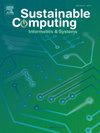Real-time energy-efficient framework for multi-source harvesting and adaptive communication IIoT networks
IF 5.7
3区 计算机科学
Q1 COMPUTER SCIENCE, HARDWARE & ARCHITECTURE
引用次数: 0
Abstract
Over the past few years, Industrial Internet of Things (IIoT) devices have proliferated across modern manufacturing ecosystems, facilitating real-time monitoring, predictive analytics, and autonomous control. Nevertheless, maintaining these devices in low-resource contexts, especially in situations where the use of wired power is impossible and battery management is not feasible, is a significant challenge. Here, we introduce a new hybrid system that combines multi-source ambient energy harvesting (vibration, heat, and RF) with a lightweight adaptive communication protocol specifically designed for energy-limited industrial settings. Harnessing real-time energy buffer levels and environmental feedback, the architecture utilizes a central middleware engine to adapt transmission behaviors, routing decisions, and node activity states. We design and test detailed models to measure the performance of the framework on major metrics such as energy usage, communication delay, packet delivery ratio, and network sustainability. We utilize a synthetic industrial case scenario with 45 IoT nodes out-deployed across three zones we show the framework's strong benefits over baseline and partial methods, reaching as high as 40 % improvement in node life, 28 % improvement in sustained throughput, and substantial improvements in node availability and energy fairness. This study provides a basis for the installation of self-sustained, resilient IoT systems in realistic industrial environments, connecting the state of the art for energy autonomy design with the state of the art in the field of communication intelligence.
多源采集和自适应通信工业物联网网络实时节能框架
在过去几年中,工业物联网(IIoT)设备在现代制造生态系统中激增,促进了实时监控、预测分析和自主控制。然而,在低资源环境下维护这些设备,特别是在不可能使用有线电源和电池管理不可行的情况下,是一项重大挑战。在这里,我们介绍了一种新的混合系统,它将多源环境能量收集(振动、热量和射频)与专为能源有限的工业环境设计的轻量级自适应通信协议相结合。该体系结构利用实时能量缓冲级别和环境反馈,利用中央中间件引擎来调整传输行为、路由决策和节点活动状态。我们设计并测试了详细的模型,以衡量框架在能源使用、通信延迟、数据包传送率和网络可持续性等主要指标上的性能。我们利用在三个区域外部署45个物联网节点的综合工业案例场景,我们展示了该框架相对于基线和部分方法的强大优势,节点寿命提高高达40% %,持续吞吐量提高28% %,节点可用性和能源公平性大幅提高。本研究为在现实工业环境中安装自我维持、弹性的物联网系统提供了基础,将能源自主设计的最新技术与通信智能领域的最新技术联系起来。
本文章由计算机程序翻译,如有差异,请以英文原文为准。
求助全文
约1分钟内获得全文
求助全文
来源期刊

Sustainable Computing-Informatics & Systems
COMPUTER SCIENCE, HARDWARE & ARCHITECTUREC-COMPUTER SCIENCE, INFORMATION SYSTEMS
CiteScore
10.70
自引率
4.40%
发文量
142
期刊介绍:
Sustainable computing is a rapidly expanding research area spanning the fields of computer science and engineering, electrical engineering as well as other engineering disciplines. The aim of Sustainable Computing: Informatics and Systems (SUSCOM) is to publish the myriad research findings related to energy-aware and thermal-aware management of computing resource. Equally important is a spectrum of related research issues such as applications of computing that can have ecological and societal impacts. SUSCOM publishes original and timely research papers and survey articles in current areas of power, energy, temperature, and environment related research areas of current importance to readers. SUSCOM has an editorial board comprising prominent researchers from around the world and selects competitively evaluated peer-reviewed papers.
 求助内容:
求助内容: 应助结果提醒方式:
应助结果提醒方式:


